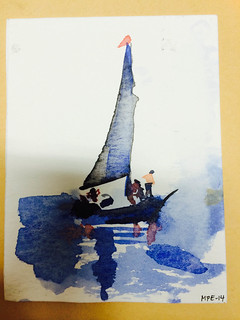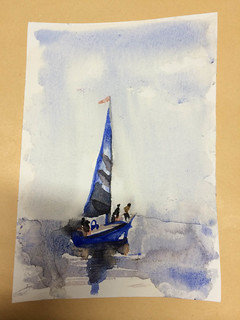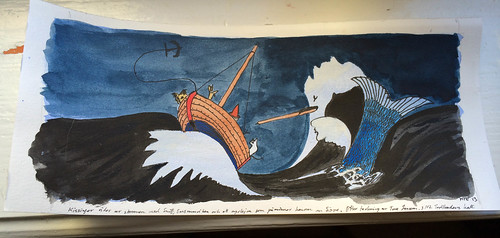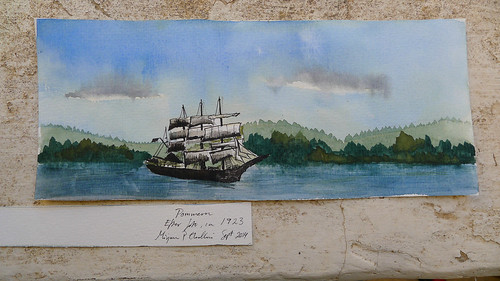Having sailed some, and being fascinated by blue prints for boats, I know a little about their construction. That doesn’t help me though. Instead, I tend to want to draw what I believe that the boat should look like. When I can free myself from that, and just see the boat, and not even think about it as a boat, it works much better. Then, I just see the shapes and the relations between them. Like in the picture below.
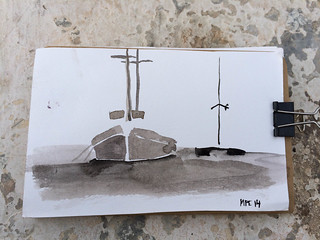 |
|
A picture I made when taking a break walking to work
in February 2014. At the time, I was practicing
making “notan” pictures. The sport being to use only one color
and three tones: white, medium, and dark. I was looking at
Fernandes II, a wooden gullet built in Turkey.
Summertime on Malta, she carries tourists
from Sliema to the blue lagoon in Gozo.
At her side is The Sprit of Malta, a catamaran.
|
If that’s all that’s needed, to not think about them as boats, then how come many books on how to paint have a little section about boats? If its just a shape like everything else, then why bother?
What I have found useful in books is how to work the technique. How to not overwork it for example. I tend to want to put in all the rigging in sailing boats, but when I look at painting of boats in books, they are often reduced in detail, and the rigging is not there. For me, a good lesson is to look at the paintings in the instruction books and note what detail they have kept and what they have omitted, and with very few brush strokes still make it look like a boat.
Another thing is to put some effort into the reflection of the boat in the water surface. It looks much better with a reflection there, at least to my eyes.
To practice, I am copying paintings of boats in books, and then I practice more by looking at boats in the wild, and paint them too.
Below are two pictures I made when I looking at a painting of a boat in the little gem of a book 10-minute Watercolours. I made the third while looking at a drawing in Tove Janssons’ book Trollkarlens Hatt (edition in Swedish, p.102).
Photos are a treasure trove for looking at boats from the past. This summer, we visited Pommern, a windjammer turned into a museum ship. It was one of the last sailing ships in use for carrying cargo. Being on board is amazing, she is massive. In the little information folder I was given was a black and white photo of her with the sails set. I looked at it when I did the image below. (I was very pleased with that I had remembered to take the folder. The word “reference image” echoed in my head. It feels so nice to be someone who would have a use of such a thing. A reference image.)
I wasn’t terribly pleased with the resulting image, so I won’t send it to anyone (if I’m not too ashamed of the picture I give it to someone, or send it as a post card). I will glue this image onto a can, so that it can become a pencil holder. I made sure that the paper had the right measurements, and that the trees align somewhat on the sides. (Much less presumptuous to give someone. “Look, here is an old can! You can put pens or some other rubbish in it! Yeah, I glued a picture to it. Don’t worry about that.”)
I plan to portray my dads boat, Evnig. I have a resistance to it for some reason, perhaps because it is not just any boat, a collection of shapes, but a home of sorts, and a friend. Thus, a difficult motive. When I think of her, I feel how the deck is warm under my hand. For now, I am collecting images of her. I expect to make many attempts before I can produce something that won’t be painful to see. (or so I hope)
Summary of how I try to learn to paint pictures of boats:
- Draw the shape I see, not the one I believe should be there
- Reduce detail
- Don’t forget the reflection in the water surface
- Practice: paint while looking at:
- other painting of boats. One learn what details need to be there, and which can be omitted.
- real boats. Harbours with benches are good places for that.
- photos of real boats. So much less wind/sun/rain onto self. Also, less bobbing about in the waves (of the boat).
